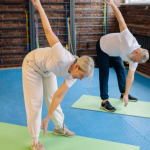Anti-Aging Skincare: A Clinical Review of Rosacea
CARRIE DECKER, ND
Much to their dismay, as some patients progress through midlife, the troublesome pustules, papules, and facial redness once thought confined to puberty can resurface. Unfortunately, even though these facial changes may appear similar to acne, if these annoying symptoms first appear in midlife, the diagnosis is most likely to be rosacea. Unlike acne, which shows up in adolescence, rosacea typically impacts individuals in their 40s and beyond. In the United States, it affects roughly 5% of adults.1,2 The following is a clinical review of current research regarding rosacea, including the pathogenesis, triggers, comorbidities, and integrative treatment approaches associated with this complex inflammatory condition.
Pathogenesis and Risk Factors
Although numerous disease associations and triggers have been identified, much remains unknown about the precise mechanisms and pathways that lead to the development of rosacea. Beyond what is known about increased inflammatory and immune responses, studies point to involvement of localized processes in the skin, alterations in microflora of the skin or gut, changes in vascular function, genetics, oxidative stress, and other important factors like associated conditions – all of which represent a complex, interconnected system of disease development.
Skin
In addition to acting as a barrier, the skin produces antimicrobial peptides (AMPs), is home to numerous immune cells, and has a pH of between 5.4-5.9, all of which help defend it from infection and colonization by potentially pathogenic flora.3 Keratinocytes and endothelial cells of the skin also have receptors that can trigger immune responses by producing various cytokines and chemokines (in addition to AMPs).
Expression of the AMP known as LL-37 has been shown to be increased in rosacea-affected skin. Research suggests that LL-37 contributes to the pathogenesis of rosacea by promoting inflammation via NLRP3 inflammasome activation and enhancing skin sensitivity to UVB radiation.4,5 Increased levels of mast cells have also been identified in skin affected by rosacea.6 Mast cells produce molecules that promote vasodilation, angiogenesis, and increase vascular permeability.7 They are also a major producer of LL-37.6 Increased levels of macrophages and a Th1/Th17 polarized immune response have additionally been demonstrated in rosacea biopsies.8
High levels of Demodex mites, normally found at low levels on human skin, have been found in skin biopsies of patients with rosacea. Dermodex mites reside in the pilosebaceous unit of the hair follicle and contribute to immune responses and increased inflammation. Increased levels of this mite have also been shown in the skin of individuals with seborrheic dermatitis and acne; however, infestation rates were demonstrated to be highest in individuals with rosacea.9
Gut
Numerous studies have found that the presence of Helicobacter pylori infection is more common in individuals with rosacea.10,11 Although not considered a risk factor, several other common gastrointestinal conditions have also been found to be more prevalent in individuals with rosacea. These include gastrointestinal reflux disease, celiac disease, Crohn’s disease and ulcerative colitis, small intestinal bacterial overgrowth (SIBO), and irritable bowel syndrome.12,13 Although the exact nature of these relationships is unknown, aspects of immune dysfunction and gut microbiota changes are suspected to be contributors.
Altered Vascular Function
In addition to increased levels and activation of mast cells, other factors that contribute to altered vascular function are implicated in rosacea. Polymorphisms in the vascular endothelial growth factor (VEGF) gene appear to contribute to the heritability of the condition.14 This growth factor not only promotes angiogenesis, it also influences blood vessel permeability and inflammation.15 Heightened expression of VEGF receptors in the endothelium and infiltrating immune cells, including lymphocytes and macrophages, has been demonstrated in patients with rosacea.16 Additionally, transient receptor potential vanilloid (TRPV) channels have been shown to be upregulated in rosacea-affected skin, and these appear to further contribute to mast cell activation.17
Genetics
As with the observed changes in VEGF receptor and TRPV channel expression, altered genetics have been associated with individuals that develop rosacea. An interesting relationship has been observed with rosacea and other immune-mediated conditions that affect the gastrointestinal system. Using 23andMe data from over 73,000 individuals with European ancestry, a genome-wide association study found that one of the gene loci thought to be related to rosacea is also associated with inflammatory bowel disease.8 Further assessment found positive genetic correlations between rosacea severity scores and Crohn’s disease, ulcerative colitis, primary biliary cirrhosis, and celiac disease.8
Oxidative Stress
Given the heightened inflammatory and immune responses seen in rosacea, it is not surprising that increased oxidative stress has also been demonstrated in individuals who struggle with the condition.18 In mild stages of disease, studies suggest that the body responds by increasing antioxidant defenses; however, in severe stages, the body’s ability to resolve oxidative stress decreases.19 Specifically, it was shown that in individuals with mild disease, superoxide dismutase (SOD) activity increased and malondialdehyde levels did not differ from controls; in those with severe disease, SOD activity was decreased and malondialdehyde levels increased.19
Other Important Factors
Conditions associated with rosacea include:
- Obesity20
- Hypertension21
- Dyslipidemia21
- Diabetes22
- Hypothyroidism23
- Rheumatoid arthritis22
- Parkinson’s disease24
- Dementia22
- Depression22
- Anxiety22
- Migraine22
Rosacea has also long been thought to be more common in individuals with fair skin. More recent research, however, suggests that the condition may be overlooked in individuals that have darker skin.25 This has likely led to disparities in management and worsened outcomes, particularly for those with a progressive form of the disease.25 Overall, up to 3 times more women experience rosacea than men;1,2 however, when subtypes and distribution are considered, rosacea in the nasal region is 2 times more common in men.20 Alcohol consumption is further associated with the more pronounced tissue hypertrophy often seen with rosacea of the nasal region, also known as phymatous changes or rhinophyma.26
Other factors that may increase the risk of, or aggravate rosacea include:
- Family history20
- Drinking hot beverages27
- Capsaicin consumption (eg, hot sauce or peppers)28
- Cinnamaldehyde consumption (found not only in cinnamon, but also tomatoes, citrus fruits, and chocolate)28
- Eating histamine-rich foods (eg, aged cheese, wine, or processed meats)29
- Drinking alcohol20,28
- Sun exposure28
- Excessive facial cleansing and exfoliation30
Integrative Treatment for Rosacea
Many different factors contribute to the symptoms and progression of rosacea, and even conventional guidelines recognize the need for an individualized approach. General recommendations include avoiding triggers that promote vasodilation (eg, alcohol, spicy foods, sun exposure), refraining from excessive or vigorous facial washing, and the use of exfoliating products. Instead, gentle facial care should be practiced. Washing the face or region of concern with a mild, pH-balanced liquid soap (with the fingers only) once daily, using a non-irritating, hypoallergenic moisturizer regularly, and applying sunscreen before sun exposure are all suggested.31,32
Pharmaceutical Interventions
Pharmaceutical strategies for managing symptoms of rosacea include a variety of drugs that act to decrease inflammation, promote vasoconstriction, and/or promote a more healthy skin microbiome.29,33-37 Topical agents that have been shown to decrease redness include topical brimonidine tartrate and oxymetazoline hydrochloride.31,36,37 When pustules and papules are of primary concern, topical metronidazole, sodium sulfacetamide/sulfur, azelaic acid, or ivermectin are recommended.31,37 Systemic antibiotics or oral isotretinoin may be used with more severe or refractory disease presentation.31,37
Isotretinoin must be used with caution as it has numerous severe side effects and is a known teratogen.33 Although metronidazole is often the first topical agent selected, a 2020 meta-analysis found that topical ivermectin was more effective for treating papulopustular rosacea.34 The authors of the study also noted that treatment with ivermectin further resulted in improved quality of life when compared with other first-line options.34
Common adverse effects of topical agents like metronidazole and brimonidine tartrate may include skin irritation, dryness, or worsening erythema, all of which can contribute to premature discontinuation of treatment.35-37 A typical timeframe for many of these topicals to be effective is at least 4 weeks.35–37
Oral antibiotics used for the treatment of rosacea are primarily from the tetracycline category, however, macrolides or metronidazole may be used if these medications are contraindicated.31,37 Oral tetracycline drugs are a primary therapy for ocular rosacea, which can be misdiagnosed as conjunctivitis, blepharitis, or dry eye disease due to similar symptoms.38–40 The combination of topical ivermectin (0.1%) and metronidazole (1%) has been shown to be very effective for eradicating Demodex mites, which appear to play a role in ocular rosacea (as well as blepharitis).39,41,42 A 1% ivermectin cream also may improve the ocular symptoms of the disease.39,41,42
A small trial of topical cromolyn sodium, a mast cell stabilizer, found that the medication decreased redness and slightly decreased levels of antimicrobial peptide LL-37.6 Other oral treatments that have been shown in small studies to have positive effects on rosacea include beta-blockers and hydroxychloroquine.31,43,44 Hydroxychloroquine may improve rosacea by reducing mast cell activation and infiltration.45 Studies have also shown that rosacea may improve with treatment of H. pylori or SIBO (when present) with antibiotics; however, a meta-analysis of 7 studies on the effect of H. pylori eradication on rosacea symptoms was unable to demonstrate statistically significant results.10,46–48
Light Therapy
Various types of laser/light therapies exist for rosacea treatment. Depending on the type of laser and the wavelengths selected, therapeutic targets can include superficial or deep vessels, treatment for telangiectasias, or skin remodeling.37 Research on the efficacy of these treatments is ongoing and some studies have shown encouraging results.37 Unfortunately, laser/light therapies tend to fall under the category of a cosmetic procedure and are not typically covered by insurance. As part of an integrative treatment approach, these therapies do show promise for symptom management and skin repair.37 Hopefully, as research continues, larger studies can be conducted to determine specific clinical guidelines for the use of laser/light therapies for this condition.
Nutritional Interventions
Zinc is an important nutrient for skin health and has been studied as a treatment for multiple skin conditions where there is immune involvement and/or a compromised barrier.49–52 It also plays a role in gut health and helps reduce intestinal permeability, even in patients with Crohn’s disease.53–56 Specific to rosacea, in a randomized, controlled, crossover study of patients who had the condition for an average of 4.4 years, supplementation of 100 mg of zinc sulfate daily for 3 months was shown to decrease disease severity scores.57 This was true for both study groups, and the authors noted that zinc supplementation appeared to be a safe and viable treatment option for rosacea that lacked significant side effects.57
In an 8-week trial, a combination product consisting of zinc (25 mg), copper (1.5 mg), nicotinamide (750 mg), and folic acid (500 mcg) was shown to improve rosacea symptoms.58 Additionally, the authors of the study noted that these results were statistically equivalent to the improvements found for those given an oral antibiotic instead.58
Another form of zinc, zinc carnosine, has been shown in human studies to promote healing of the gut lining as well as improve eradication of H. pylori.59 While research specific to this nutrient for rosacea is lacking, it is also worthy of consideration as a supplementation option.59
Vitamin A is another nutrient commonly found in supplements that target skin health. Oral isotretinoin, which is used to treat severe acne as well as rosacea, and topical tretinoin and adapalene, which are also used for the same skin conditions, are all vitamin A derivatives.60–62 The benefits of retinoids include improved skin thickness and turnover, sebum production, epidermal barrier integrity, and increased protection from ultraviolet radiation.52 The positive findings with these vitamin A derivates (both orally and topically) suggest that supplementation with this nutrient may be of benefit for rosacea.33,62,63 Much like isotretinoin, vitamin A can have adverse effects in high doses and should be used with caution. When taken as a pre-formed vitamin (retinol or retinyl ester), 10 000 IU (3 000 mcg) daily is the Tolerable Upper Intake Level.64,65
Caffeine’s action as a vasoconstrictor may be one mechanism by which regular caffeine intake can decrease the risk of rosacea. A study of more than 82,000 women found a significant inverse association between caffeinated coffee consumption and rosacea.66 Specifically, women that consumed 4 or more cups of coffee per day were found to have a decreased risk for developing rosacea when compared to women that consumed less than 1 cup per month.66 A relationship was not seen between other caffeinated products or with decaffeinated coffee and rosacea risk.66 Despite its potential benefit, consumption of very hot coffee may aggravate rosacea by promoting temporary flushing.67
When H. pylori is present in a patient with rosacea, dietary supplements that have shown benefit for treatment of both H. pylori and rosacea include non-viable (killed) Lactobacillus reuteri DSMZ 17648, mastic gum, licorice, and N-acetylcysteine (NAC).68-71 Mastic gum also has been shown to reduce inflammation and markers of disease activity in patients with Crohn’s disease.72 NAC has been shown to reduce the number of inflammatory lesions in acne, and it may also help resolve skin-picking behaviors that can further worsen rosacea flare-ups.73
For individuals experiencing the irritating ocular symptoms of rosacea, omega-3 fatty acids may provide additional relief. In a randomized, controlled trial of 130 individuals with rosacea that were also experiencing ocular dry eye symptoms, supplementation of a combination of 120 mg of DHA and 180 mg of EPA twice daily for 6 months significantly improved symptoms.74 Results were generally experienced by participants within the first month; improvements in objective parameters related to the protective moisturizing tear film (Schirmer tear score, Meibomian gland score, and tear film breakup time) were seen within 3 months.74
Botanicals
In addition to its antimicrobial properties, Artemisia annua contains artemisinin, which has been shown to have anti-inflammatory, antioxidative, and anti-angiogenic effects.76–78 Given this wide range of properties, it has been investigated in animals as a treatment for rosacea. In a 2019 study, mice were given artemisinin daily for 7 days before receiving multiple injections of LL-37, the peptide implicated in rosacea.79 The mice that consumed artemisinin were protected not only from rosacea-like inflammatory skin changes, but researchers found less angiogenesis, decreased immune cell infiltration, and reduced expression of pro-inflammatory cytokines in these mice. In vitro experiments that accompanied the animal study also showed that artemisinin reduced migration of endothelial cells. This finding further supports the anti-angiogenic properties of artemisinin suggested by other research.79 Artemether, another compound derived from Artemisia annua, and an extract of Quassia amara, another botanical with broad antimicrobial effects, have both been shown to improve rosacea in human studies.80,81
Because oxidative stress plays a role in the pathogenesis of rosacea, particularly in severe cases, botanicals with high levels of antioxidant activity may be beneficial.19 When added to topical preparations, licochalcone A (derived from licorice), silymarin (derived from milk thistle), and epigallocatechin-3-gallate (derived from green tea) all showed improved treatment outcomes for rosacea.82,83
Conclusion
The discomfort, redness, and facial changes associated with rosacea are often disconcerting for patients. It is important to recognize that despite the relative complexity of the pathogenesis of this condition, much is known to help guide patients toward reducing or eliminating their symptoms. Rosacea can have many variations in its presentation and/or triggers, which can complicate treatment decisions. By continuing to expand your knowledge base, more options become available to help identify which types of treatment will work best for each individual patient.
[Refs]- Gether L, Overgaard LK, Egeberg A, Thyssen JP. Incidence and prevalence of rosacea: a systematic review and meta-analysis. Br J Dermatol. 2018;179(2):282-289.
- Tan J, Schöfer H, Araviiskaia E, et al. Prevalence of rosacea in the general population of Germany and Russia – The RISE study. J Eur Acad Dermatol Venereol. 2016;30(3):428-434.
- Nguyen AV, Soulika AM. The Dynamics of the Skin’s Immune System. Int J Mol Sci. 2019;20(8):1811.
- Yoon SH, Hwang I, Lee E, et al. Antimicrobial Peptide LL-37 Drives Rosacea-Like Skin Inflammation in an NLRP3-Dependent Manner. J Invest Dermatol. 2021;141(12):2885-2894.e5.
- Kulkarni NN, Takahashi T, Sanford JA, et al. Innate Immune Dysfunction in Rosacea Promotes Photosensitivity and Vascular Adhesion Molecule Expression. J Invest Dermatol. 2020;140(3):645-655.e6.
- Muto Y, Wang Z, Vanderberghe M, et al. Mast cells are key mediators of cathelicidin-initiated skin inflammation in rosacea. J Invest Dermatol. 2014;134(11):2728-2736.
- Wang L, Wang YJ, Hao D, et al. The Theranostics Role of Mast Cells in the Pathophysiology of Rosacea. Front Med (Lausanne). 2020;6:324.
- Aponte JL, Chiano MN, Yerges-Armstrong LM, et al. Assessment of rosacea symptom severity by genome-wide association study and expression analysis highlights immuno-inflammatory and skin pigmentation genes. Hum Mol Genet. 2018;27(15):2762-2772.
- Aktaş Karabay E, Aksu Çerman A. Demodex folliculorum infestations in common facial dermatoses: acne vulgaris, rosacea, seborrheic dermatitis. An Bras Dermatol. 2020;95(2):187-193.
- Jørgensen AR, Egeberg A, Gideonsson R, et al. Rosacea is associated with Helicobacter pylori: a systematic review and meta-analysis. J Eur Acad Dermatol Venereol. 2017;31(12):2010-2015.
- Yang X. Relationship between Helicobacter pylori and Rosacea: review and discussion. BMC Infect Dis. 2018;18(1):318.
- Egeberg A, Weinstock LB, Thyssen EP, et al. Rosacea and gastrointestinal disorders: a population-based cohort study. Br J Dermatol. 2017;176(1):100-106.
- Wang FY, Chi CC. Rosacea, Germs, and Bowels: A Review on Gastrointestinal Comorbidities and Gut-Skin Axis of Rosacea. Adv Ther. 2021;38(3):1415-1424.
- Hayran Y, Lay I, Mocan MC, et al. Vascular endothelial growth factor gene polymorphisms in patients with rosacea: A case-control study. J Am Acad Dermatol. 2019;81(2):348-354.
- Proescholdt MA, Heiss JD, Walbridge S, et al. Vascular endothelial growth factor (VEGF) modulates vascular permeability and inflammation in rat brain. J Neuropathol Exp Neurol. 1999;58(6):613-627.
- Smith JR, Lanier VB, Braziel RM, et al. Expression of vascular endothelial growth factor and its receptors in rosacea. Br J Ophthalmol. 2007;91(2):226-229.
- Mascarenhas NL, Wang Z, Chang YL, Di Nardo A. TRPV4 Mediates Mast Cell Activation in Cathelicidin-Induced Rosacea Inflammation. J Invest Dermatol. 2017;137(4):972-975.
- Erdogan HK, Bulur I, Kocaturk E, et al. Advanced oxidation protein products and serum total oxidant/antioxidant status levels in rosacea. Postepy Dermatol Alergol. 2018;35(3):304-308.
- Oztas MO, Balk M, Ogüs E, et al. The role of free oxygen radicals in the aetiopathogenesis of rosacea. Clin Exp Dermatol. 2003;28(2):188-192.
- Wu AK, Liu FF, Xie HF, et al. Clinical Features and Risk Factors for Nasal Rosacea: A Hospital-Based Retrospective Study. Dermatol Ther (Heidelb). 2021;11(6):1953-1963.
- Li Y, Guo L, Hao D, et al. Association between Rosacea and Cardiovascular Diseases and Related Risk Factors: A Systematic Review and Meta-Analysis. Biomed Res Int. 2020;2020:7015249.
- Haber R, El Gemayel M. Comorbidities in rosacea: A systematic review and update. J Am Acad Dermatol. 2018;78(4):786-792.e8.
- Akin Belli A, Alatas ET, Kara Polat A, Akbaba G. Assessment of thyroid disorders in patients with rosacea: a large case-control study. An Bras Dermatol. 2021;96(5):539-543.
- Shah P, Sagar PR, Alhumaidi N, et al. Parkinson’s Disease and Its Dermatological Associations: Is Your Skin Whispering You a Diagnosis?. Cureus. 2020;12(8):e9933.
- Alexis AF, Callender VD, Baldwin HE, et al. Global epidemiology and clinical spectrum of rosacea, highlighting skin of color: Review and clinical practice experience. J Am Acad Dermatol. 2019;80(6):1722-1729.e7.
- Liu L, Xue Y, Chen Y, et al. Alcohol consumption and the risk of rosacea: A systematic review and meta-analysis [published online ahead of print, 2021 Sep 28]. J Cosmet Dermatol. 2021;10.1111/jocd.14483.
- Wang B, Yan B, Zhao Z, et al. Relationship Between Tea Drinking Behaviour and Rosacea: A Clinical Case-control Study. Acta Derm Venereol. 2021;101(6):adv00488.
- Weiss E, Katta R. Diet and rosacea: the role of dietary change in the management of rosacea. Dermatol Pract Concept. 2017;7(4):31-37.
- Searle T, Ali FR, Carolides S, Al-Niaimi F. Rosacea and Diet: What is New in 2021?. J Clin Aesthet Dermatol. 2021;14(12):49-54.
- Li G, Wang B, Zhao Z, et al. Excessive cleansing: an underestimating risk factor of rosacea in Chinese population. Arch Dermatol Res. 2021;313(4):225-234.
- Zhang H, Tang K, Wang Y, et al. Rosacea Treatment: Review and Update. Dermatol Ther (Heidelb). 2021;11(1):13-24.
- Levin J, Miller R. A Guide to the Ingredients and Potential Benefits of Over-the-Counter Cleansers and Moisturizers for Rosacea Patients. J Clin Aesthet Dermatol. 2011;4(8):31-49.
- Bagatin E, Costa CS, Rocha MADD, et al. Consensus on the use of oral isotretinoin in dermatology – Brazilian Society of Dermatology. An Bras Dermatol. 2020;95 Suppl 1(Suppl 1):19-38.
- Husein-ElAhmed H, Steinhoff M. Efficacy of topical ivermectin and impact on quality of life in patients with papulopustular rosacea: A systematic review and meta-analysis. Dermatol Ther. 2020;33(1):e13203.
- Wolf JE Jr, Del Rosso JQ. The CLEAR trial: results of a large community-based study of metronidazole gel in rosacea. Cutis. 2007;79(1):73-80.
- Jackson JM, Knuckles M, Minni JP, et al. The role of brimonidine tartrate gel in the treatment of rosacea. Clin Cosmet Investig Dermatol. 2015;8:529-538.
- Sharma A, Kroumpouzos G, Kassir M, et al. Rosacea management: A comprehensive review. J Cosmet Dermatol. 2022;21(5):1895-1904.
- Woo YR, Cho M, Ju HJ, et al. Ocular Comorbidities in Rosacea: A Case-Control Study Based on Seven Institutions. J Clin Med. 2021;10(13):2897.
- Vieira AC, Mannis MJ. Ocular rosacea: common and commonly missed. J Am Acad Dermatol. 2013;69(6 Suppl 1):S36-S41.
- Jabbehdari S, Memar OM, Caughlin B, Djalilian AR. Update on the pathogenesis and management of ocular rosacea: an interdisciplinary review. Eur J Ophthalmol. 2021;31(1):22-33.
- Ávila MY, Martínez-Pulgarín DF, Rizo Madrid C. Topical ivermectin-metronidazole gel therapy in the treatment of blepharitis caused by Demodex spp.: A randomized clinical trial. Cont Lens Anterior Eye. 2021;44(3):101326.
- Sobolewska B, Doycheva D, Deuter CM, et al. Efficacy of Topical Ivermectin for the Treatment of Cutaneous and Ocular Rosacea. Ocul Immunol Inflamm. 2021;29(6):1137-1141.
- Logger JGM, Olydam JI, Driessen RJB. Use of beta-blockers for rosacea-associated facial erythema and flushing: A systematic review and update on proposed mode of action. J Am Acad Dermatol. 2020;83(4):1088-1097.
- Wang B, Yuan X, Huang X, et al. Efficacy and safety of hydroxychloroquine for treatment of patients with rosacea: A multicenter, randomized, double-blind, double-dummy, pilot study. J Am Acad Dermatol. 2021;84(2):543-545.
- Marchitto MC, Chien AL. Mast Cell Stabilizers in the Treatment of Rosacea: A Review of Existing and Emerging Therapies. Dermatol Ther (Heidelb). 2021;11(5):1541-1549.
- Weinstock LB, Steinhoff M. Rosacea and small intestinal bacterial overgrowth: prevalence and response to rifaximin. J Am Acad Dermatol. 2013;68(5):875-876.
- Parodi A, Paolino S, Greco A, et al. Small intestinal bacterial overgrowth in rosacea: clinical effectiveness of its eradication. Clin Gastroenterol Hepatol. 2008;6(7):759-764.
- Gravina A, Federico A, Ruocco E, et al. Helicobacter pylori infection but not small intestinal bacterial overgrowth may play a pathogenic role in rosacea. United European Gastroenterol J. 2015;3(1):17-24.
- Akhavan S, Mohammadi SR, Modarres Gillani M, et al. Efficacy of combination therapy of oral zinc sulfate with imiquimod, podophyllin or cryotherapy in the treatment of vulvar warts. J Obstet Gynaecol Res. 2014;40(10):2110-2113.
- Al-Gurairi FT, Al-Waiz M, Sharquie KE. Oral zinc sulphate in the treatment of recalcitrant viral warts: randomized placebo-controlled clinical trial. Br J Dermatol. 2002;146(3):423-431.
- Al-Kaisy AA, Salih Sahib A, Al-Biati HA. Effect of zinc supplement in the prognosis of burn patients in iraq. Ann Burns Fire Disasters. 2006;19(3):115-122.
- Michalak M, Pierzak M, Kręcisz B, Suliga E. Bioactive Compounds for Skin Health: A Review. Nutrients. 2021;13(1):203.
- El-Tawil AM. Zinc supplementation tightens leaky gut in Crohn’s disease. Inflamm Bowel Dis. 2012;18(2):E399.
- Tran CD, Hawkes J, Graham RD, et al. Zinc-fortified oral rehydration solution improved intestinal permeability and small intestinal mucosal recovery. Clin Pediatr (Phila). 2015;54(7):676-682.
- Mahmood A, FitzGerald AJ, Marchbank T, et al. Zinc carnosine, a health food supplement that stabilises small bowel integrity and stimulates gut repair processes. Gut. 2007;56(2):168-175.
- Davison G, Marchbank T, March DS, Thatcher R, Playford RJ. Zinc carnosine works with bovine colostrum in truncating heavy exercise-induced increase in gut permeability in healthy volunteers. Am J Clin Nutr. 2016;104(2):526-536.
- Sharquie KE, Najim RA, Al-Salman HN. Oral zinc sulfate in the treatment of rosacea: a double-blind, placebo-controlled study. Int J Dermatol. 2006;45(7):857-861.
- Niren NM, Torok HM. The Nicomide Improvement in Clinical Outcomes Study (NICOS): results of an 8-week trial. Cutis. 2006;77(1 Suppl):17-28.
- Hewlings S, Kalman D. A Review of Zinc-L-Carnosine and Its Positive Effects on Oral Mucositis, Taste Disorders, and Gastrointestinal Disorders. Nutrients. 2020;12(3):665.
- Altinyazar HC, Koca R, Tekin NS, Eştürk E. Adapalene vs. metronidazole gel for the treatment of rosacea. Int J Dermatol. 2005;44(3):252-255.
- Ertl GA, Levine N, Kligman AM. A comparison of the efficacy of topical tretinoin and low-dose oral isotretinoin in rosacea. Arch Dermatol. 1994;130(3):319-324.
- Kotori MG. Low-dose Vitamin “A” Tablets-treatment of Acne Vulgaris. Med Arch. 2015;69(1):28-30.
- Gollnick H, Blume-Peytavi U, Szabó EL, et al. Systemic isotretinoin in the treatment of rosacea – doxycycline- and placebo-controlled, randomized clinical study. J Dtsch Dermatol Ges. 2010;8(7):505-515.
- Duerbeck NB, Dowling DD. Vitamin A: too much of a good thing?. Obstet Gynecol Surv. 2012;67(2):122-128.
- Olson JM, Ameer MA, Goyal A. Vitamin A Toxicity. Last updated December 29, 2021. In: StatPearls. Treasure Island (FL): StatPearls Publishing; 2022 Jan-. Available at: https://www.ncbi.nlm.nih.gov/books/NBK532916/. Accessed May 1, 2022.
- Li S, Chen ML, Drucker AM, et al. Association of Caffeine Intake and Caffeinated Coffee Consumption With Risk of Incident Rosacea in Women. JAMA Dermatol. 2018;154(12):1394-1400.
- Wilkin JK. Oral thermal-induced flushing in erythematotelangiectatic rosacea. J Invest Dermatol. 1981;76(1):15-18.
- Mehling H, Busjahn A. Non-viable Lactobacillus reuteri DSMZ 17648 (Pylopass™) as a new approach to Helicobacter pylori control in humans. Nutrients. 2013;5(8):3062-3073.
- Yoon H, Lee DH, Jang ES, et al. Effects of N-acetylcysteine on First-Line Sequential Therapy for Helicobacter pylori Infection: A Randomized Controlled Pilot Trial. Gut Liver. 2016;10(4):520-525.
- Hajiaghamohammadi AA, Zargar A, Oveisi S, et al. To evaluate of the effect of adding licorice to the standard treatment regimen of Helicobacter pylori. Braz J Infect Dis. 2016;20(6):534-538.
- Dabos KJ, Sfika E, Vlatta LJ, Giannikopoulos G. The effect of mastic gum on Helicobacter pylori: a randomized pilot study. Phytomedicine. 2010;17(3-4):296-299.
- Kaliora AC, Stathopoulou MG, Triantafillidis JK, et al. Chios mastic treatment of patients with active Crohn’s disease. World J Gastroenterol. 2007;13(5):748-753.
- Mardani N, Mozafarpoor S, Goodarzi A, Nikkhah F. A systematic review of N-acetylcysteine for treatment of acne vulgaris and acne-related associations and consequences: Focus on clinical studies. Dermatol Ther. 2021;34(3):e14915.
- Bhargava R, Chandra M, Bansal U, et al. A Randomized Controlled Trial of Omega 3 Fatty Acids in Rosacea Patients with Dry Eye Symptoms. Curr Eye Res. 2016;41(10):1274-1280.
- van Zuuren EJ, Fedorowicz Z, Tan J, et al. Interventions for rosacea based on the phenotype approach: an updated systematic review including GRADE assessments. Br J Dermatol. 2019;181(1):65-79.
- Li J, Zhang C, Gong M, Wang M. Combination of artemisinin-based natural compounds from Artemisia annua L. for the treatment of malaria: Pharmacodynamic and pharmacokinetic studies. Phytother Res. 2018;32(7):1415-1420.
- Kim WS, Choi WJ, Lee S, et al. Anti-inflammatory, Antioxidant and Antimicrobial Effects of Artemisinin Extracts from Artemisia annua L. Korean J Physiol Pharmacol. 2015;19(1):21-27.
- Wei T, Liu J. Anti-angiogenic properties of artemisinin derivatives (Review). Int J Mol Med. 2017;40(4):972-978.
- Yuan X, Li J, Li Y, et al. Artemisinin, a potential option to inhibit inflammation and angiogenesis in rosacea. Biomed Pharmacother. 2019;117:109181.
- Ferrari A, Diehl C. Evaluation of the efficacy and tolerance of a topical gel with 4% quassia extract in the treatment of rosacea. J Clin Pharmacol. 2012;52(1):84-88.
- Wang GJ, Gao XY, Wu Y, et al. Evaluation of the efficacy and tolerance of artemether emulsion for the treatment of papulopustular rosacea: a randomized pilot study. J Dermatolog Treat. 2019;30(8):809-812.
- Saric S, Clark AK, Sivamani RK, et al. The Role of Polyphenols in Rosacea Treatment: A Systematic Review. J Altern Complement Med. 2017;23(12):920-929.
- Domingo DS, Camouse MM, Hsia AH, et al. Anti-angiogenic effects of epigallocatechin-3-gallate in human skin. Int J Clin Exp Pathol. 2010;3(7):705-709.

Carrie Decker, ND, graduated with honors from the National College of Natural Medicine (now the National University of Natural Medicine) in Portland, OR. Prior to becoming a naturopathic physician, Dr Decker was an engineer and obtained graduate degrees in biomedical and mechanical engineering from the University of Wisconsin-Madison and University of Illinois at Urbana-Champaign, respectively. She continues to enjoy academic research and writing and uses these skills to support integrative medicine education as a writer and contributor to various resources. Dr Decker supports Life Extensions as the director of their Scientific Affairs team.










